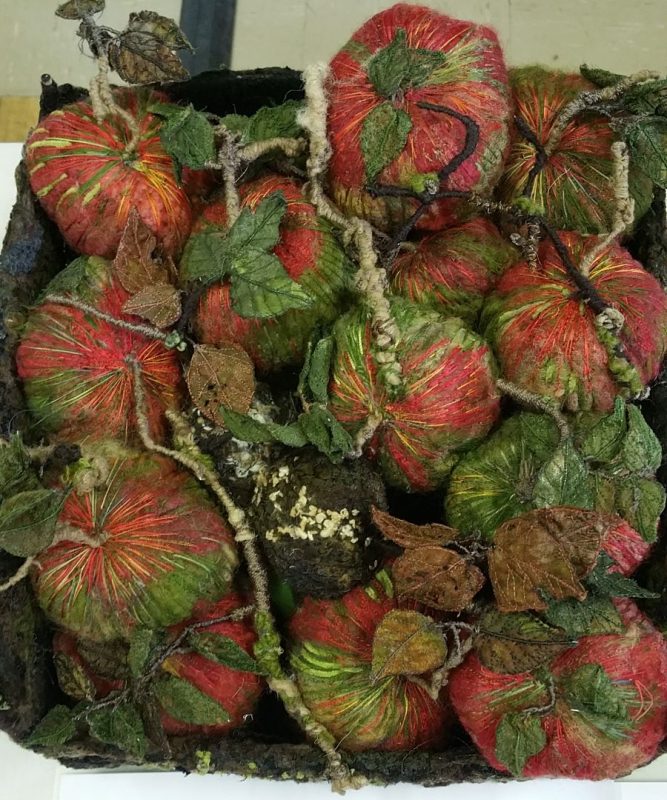 We had some very different work to look at during our November meeting, when we heard a fascinating talk by Heather Collins, textile artist. Heather brought a wonderful selection of her work to show us, and talked us through her textile journey and some of her inspirations and techniques.
We had some very different work to look at during our November meeting, when we heard a fascinating talk by Heather Collins, textile artist. Heather brought a wonderful selection of her work to show us, and talked us through her textile journey and some of her inspirations and techniques.
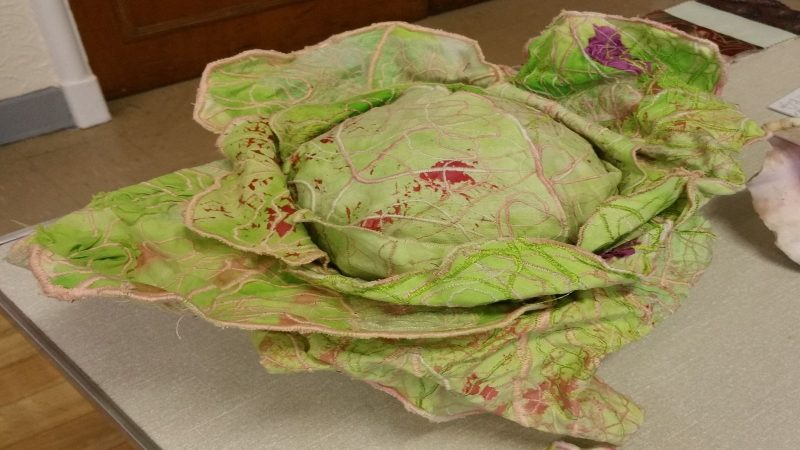 Heather grew up in a creative family (her mother was accomplished at pattern-cutting and tailoring) but despite this background Heather didn’t take to needlework while she was at school. She came back to textiles in her mid-thirties, when she took a course in patchwork and joined the Brighton branch of the Embroiderers Guild. Two things added to the inspiration that she began to feel: one was doing an ‘A’ Level in Art, and the other was signing up for a machine-embroidery course with Wendy Dolan. Many of our own members have been inspired by Wendy’s teaching, so there were many understanding nods when Heather described how her interest developed. The machine-stitched cabbage above was one of the pieces that she made during this time. Heather described the experience of ‘the lid being lifted off’, so that she was able to really look and observe.
Heather grew up in a creative family (her mother was accomplished at pattern-cutting and tailoring) but despite this background Heather didn’t take to needlework while she was at school. She came back to textiles in her mid-thirties, when she took a course in patchwork and joined the Brighton branch of the Embroiderers Guild. Two things added to the inspiration that she began to feel: one was doing an ‘A’ Level in Art, and the other was signing up for a machine-embroidery course with Wendy Dolan. Many of our own members have been inspired by Wendy’s teaching, so there were many understanding nods when Heather described how her interest developed. The machine-stitched cabbage above was one of the pieces that she made during this time. Heather described the experience of ‘the lid being lifted off’, so that she was able to really look and observe.
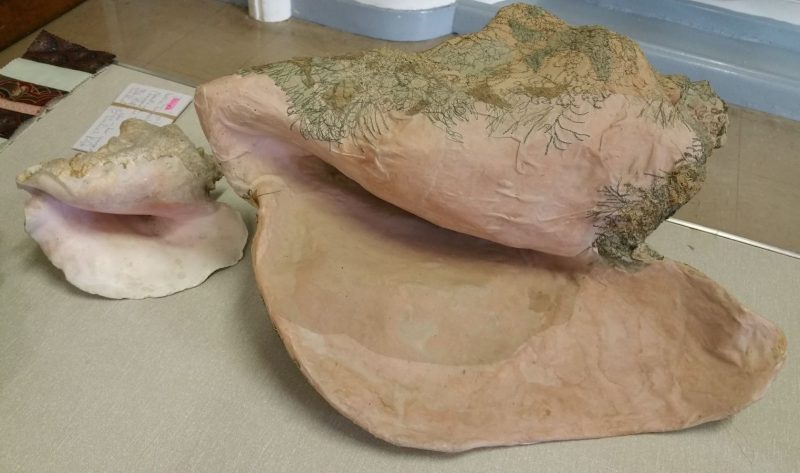
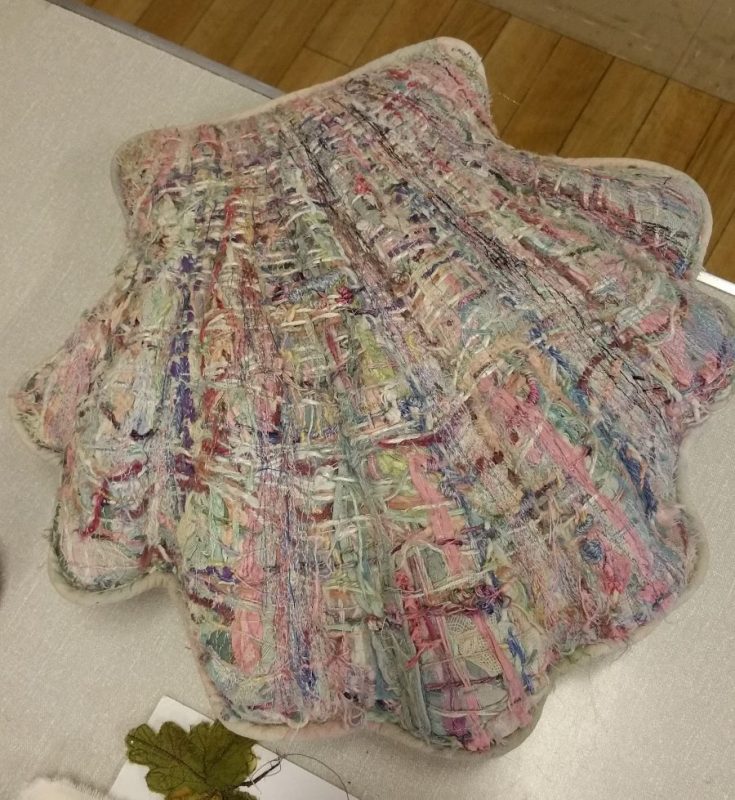 Heather began to see things with fresh eyes, and found inspiration on the natural world. She was very fortunate to do a City and Guilds Part 1 course at Windsor with Jan and Jean, which of course was an inspiring experience. She developed more skills in machine and hand embroidery, as well as observation skills.
Heather began to see things with fresh eyes, and found inspiration on the natural world. She was very fortunate to do a City and Guilds Part 1 course at Windsor with Jan and Jean, which of course was an inspiring experience. She developed more skills in machine and hand embroidery, as well as observation skills.
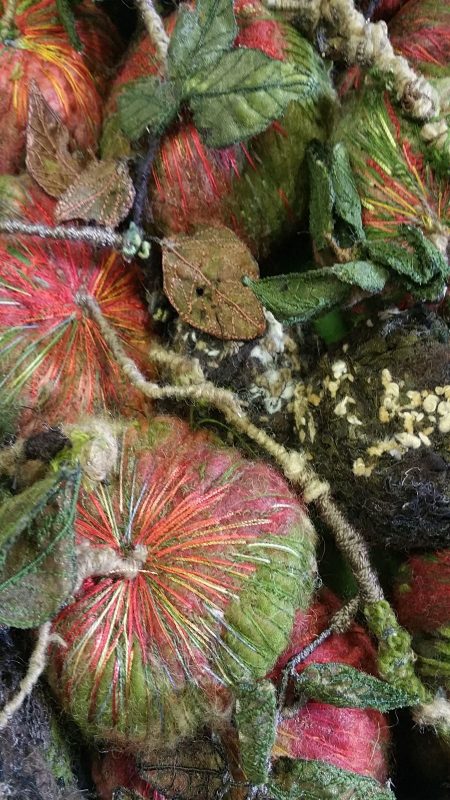 Heather decided not to go on to Part 2 (Diploma) as she already had so many ideas that she wanted to pursue. Three-dimensional work became more and more of a fascination, as shown by the detail of the apples above. She shared some really helpful tips on the foundations she uses for 3D work, for example chicken wire, muslin with non-fungicidal glue, or insulation foam that can be cut to shape and covered with stitched scrim and PVA glue. Her main inspiration remained the natural world; for example vegetation, bark, shells, seaweed, wood, stones etc.
Heather decided not to go on to Part 2 (Diploma) as she already had so many ideas that she wanted to pursue. Three-dimensional work became more and more of a fascination, as shown by the detail of the apples above. She shared some really helpful tips on the foundations she uses for 3D work, for example chicken wire, muslin with non-fungicidal glue, or insulation foam that can be cut to shape and covered with stitched scrim and PVA glue. Her main inspiration remained the natural world; for example vegetation, bark, shells, seaweed, wood, stones etc.
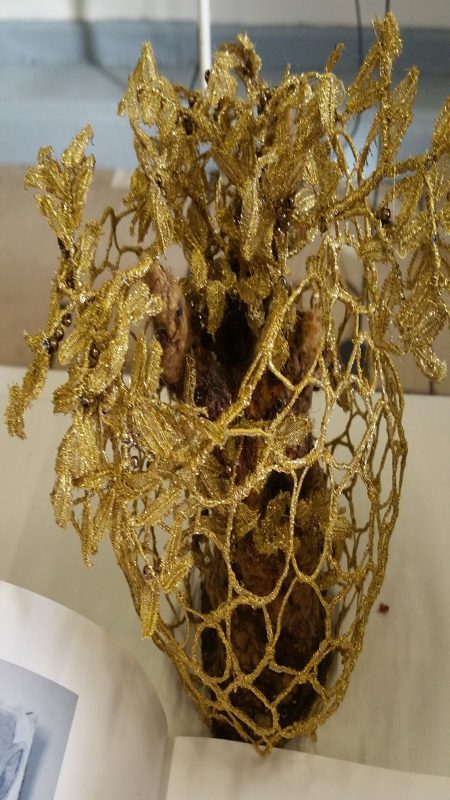 Over the years Heather has exhibited at Ramster, and Brighton Open Studios. She has also entered and been successful in a series of textile art exhibitions in France. The encased olive tree above is an example of one of her exhibits in France (it was of particular interest to the Mixed Media sub-group as we will be doing some work based on twisted wire forms in the new year).
Over the years Heather has exhibited at Ramster, and Brighton Open Studios. She has also entered and been successful in a series of textile art exhibitions in France. The encased olive tree above is an example of one of her exhibits in France (it was of particular interest to the Mixed Media sub-group as we will be doing some work based on twisted wire forms in the new year).
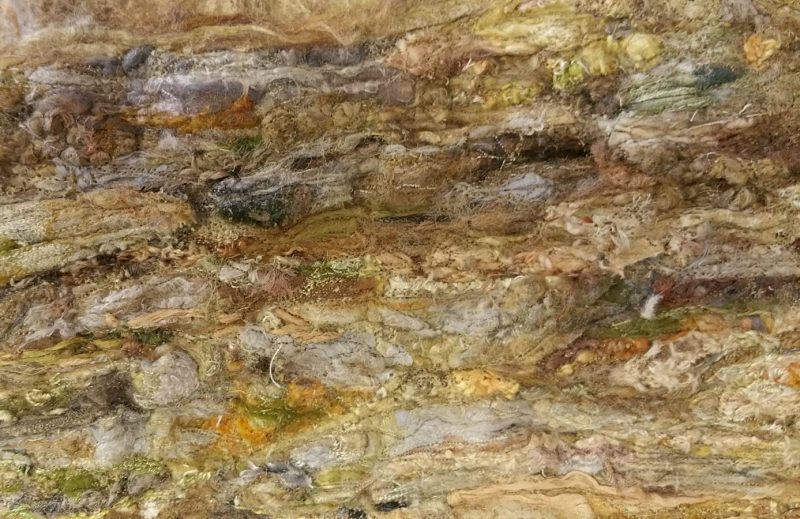
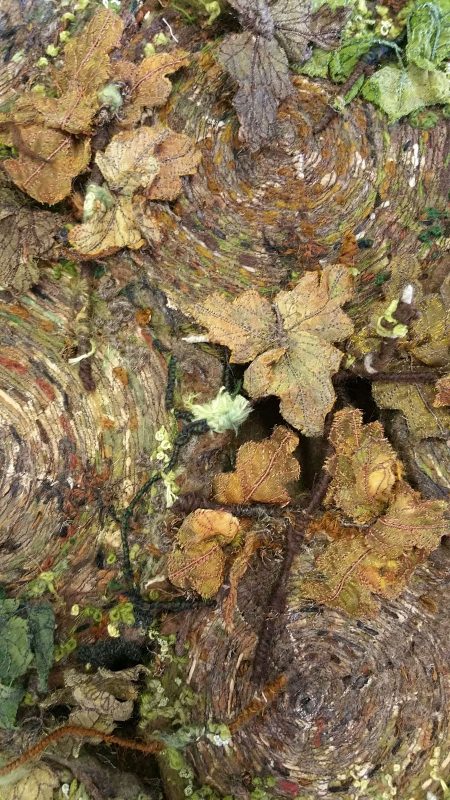 Heather’s work is built up from layer upon layer of threads and snippets, which are stitched intensively to form a background. On 3D pieces this is sometimes shaped into a ‘jacket’ that is stitched round the inner ‘former’, and the smaller details are then stitched on to that. She tends to use a limited range of stitches (straight stitch, French knots and bullion knots). When telling us about the smaller hand-stitched details that are added, Heather told us one of the funniest anecdotes that we had heard for some time. She spent several days hand-stitching lots of small mussel-shells based on chicken-wire, that that she was going to apply to a background. She left them on the coffee-table in the living room, but when she came back every one of them had disappeared…but there was no-one else in the house. The mystery was solved when she realised that her chocolate Labrador was looking rather sheepish: he had eaten them all. Luckily the dog was alright, but he cost her a big vets bill and two days work!
Heather’s work is built up from layer upon layer of threads and snippets, which are stitched intensively to form a background. On 3D pieces this is sometimes shaped into a ‘jacket’ that is stitched round the inner ‘former’, and the smaller details are then stitched on to that. She tends to use a limited range of stitches (straight stitch, French knots and bullion knots). When telling us about the smaller hand-stitched details that are added, Heather told us one of the funniest anecdotes that we had heard for some time. She spent several days hand-stitching lots of small mussel-shells based on chicken-wire, that that she was going to apply to a background. She left them on the coffee-table in the living room, but when she came back every one of them had disappeared…but there was no-one else in the house. The mystery was solved when she realised that her chocolate Labrador was looking rather sheepish: he had eaten them all. Luckily the dog was alright, but he cost her a big vets bill and two days work!
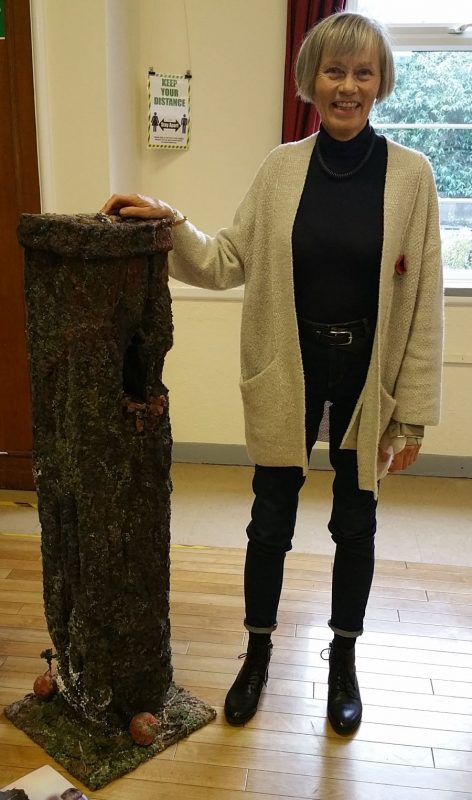 One of the fascinating things about Heather’s work is the way she combines intricate detail with large-scale work, a process that makes her work very distinctive (and time-consuming). The picture above shows Heather with one of her 3D pieces inspired by a wooden groyne (the photo doesn’t how how the surface is entirely covered in stitched detail). Sometimes people mistake her art for ‘the real thing’ and have to touch it to believe that it is hand-made.
One of the fascinating things about Heather’s work is the way she combines intricate detail with large-scale work, a process that makes her work very distinctive (and time-consuming). The picture above shows Heather with one of her 3D pieces inspired by a wooden groyne (the photo doesn’t how how the surface is entirely covered in stitched detail). Sometimes people mistake her art for ‘the real thing’ and have to touch it to believe that it is hand-made.
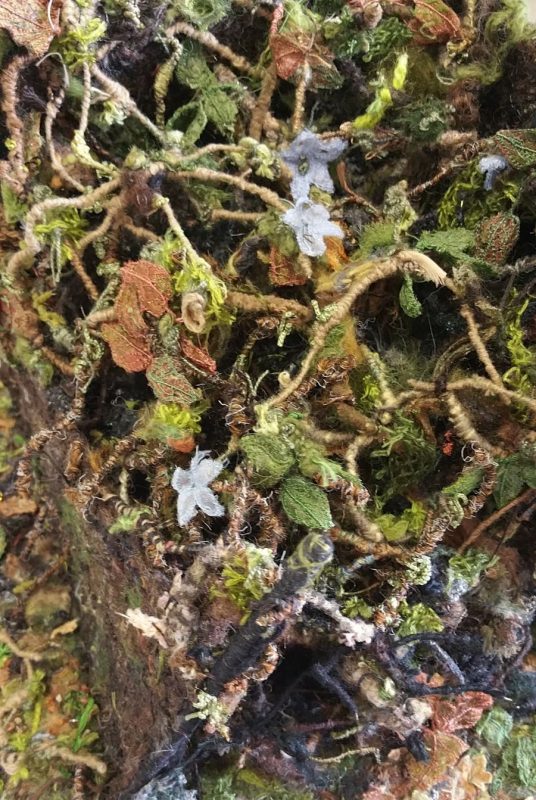 One of the memorable things about Heather’s talk was her description of how stitching has helped her through difficult times in her life, and what a wonderful thing it is for mental/emotional well-being (I think we can all relate to that!) She spoke about ‘the spark’ that ignites when you really look around you and see the natural world and want to interpret it in art. Seeing how people responded to her work also showed how that ‘spark’ can be passed from one person to another.
One of the memorable things about Heather’s talk was her description of how stitching has helped her through difficult times in her life, and what a wonderful thing it is for mental/emotional well-being (I think we can all relate to that!) She spoke about ‘the spark’ that ignites when you really look around you and see the natural world and want to interpret it in art. Seeing how people responded to her work also showed how that ‘spark’ can be passed from one person to another.
